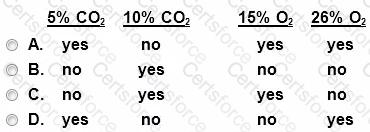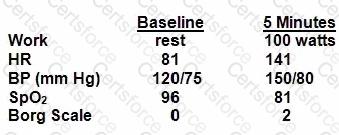To facilitate measurement of arterial oxygen content during an exercise (stress) test, a pulmonary function technologist should recommend
During a bronchial provocation study, a patient has the following spirometric values after a 0.25 mg/mL dose of methacholine:

Based on these results, a pulmonary function technologist should
During a cardiopulmonary stress test using breath-by-breath gas analysis, a pulmonary function technologist notices that the VO2suddenly decreases. Which of the following may explain this change?
1. The patient has achieved anaerobic threshold.
2. The measurement of the expired gas volumes is inaccurate.
3. O2analyzer "phase delay" has increased.
4. There is a leak in the tubing or mouthpiece.
A pulmonary function technologist reviews the following home monitoring spirometry results:
According to National Asthma Education and Prevention Program (NAEPP) guidelines, what feedback should the technologist give to the patient regarding test performance?
The following data are obtained after an exercise (stress) test for exercise-induced asthma:

Based on these data, the post-exercise FEVi represents a decrease of approximately
Pulmonary function tests performed on a patient with tracheal stenosis may demonstrate increased
An isothermal lung analog has the following specifications:
5-L glass bottle
2000 g of steel wool
Density of steel wool 5 g/cm3
Volume of connectors and bulb 100 mi-Repeated FRC measurements in the plethysmograph result in a volume of 5.5 L.
Which of the following should a pulmonary function technologist do?
During the calibration and set-up of the metabolic stress testing system for a patient breathing supplemental oxygen, which of the following gas concentrations will ensure accurate calibration of the system?

A 35-year-old healthy male is performing a maximal stress test as part of an annual physical. The following data are observed:

The patient denies any symptoms. Which of the following should a pulmonary function technologist do first?
A pulmonary function technologist is performing quality control on a nebulizer used in the 5-breath dosimeter bronchial challenge. The target output of the device is 0.09 mL, plus or minus 10%. After 10 actuations, the nebulizer output was 75 µL with a 2.0 mL initial saline dose in the nebulizer. The technologist should